Marketing in Travel and Tourism: Thomas Cook Report Analysis
VerifiedAdded on 2020/07/22
|12
|3544
|25
Report
AI Summary
This report delves into the realm of marketing within the travel and tourism sector, focusing on the application of marketing principles to a tour operator company, specifically Thomas Cook. The report begins with an introduction to the fundamental concepts of marketing, including customer needs, customer value, and the importance of understanding customer demand. It then explores the impact of both micro and macro environmental factors on marketing strategies, such as customer behavior, competitor analysis, technological advancements, and socio-cultural considerations. The report further examines factors influencing consumer motivation and demand, including purchasing power, buying behavior, economic conditions, and personal preferences. A significant portion of the report is dedicated to market segmentation, highlighting psychographic, geographic, and demographic segmentation techniques. Finally, the report explores the importance of strategic marketing planning, including the Ansoff Matrix (market penetration, market development, product development, and diversification), and the role of marketing research and information in the tourism sector. The report uses Thomas Cook as a case study, analyzing their holiday packages in Morocco and Egypt, providing a comprehensive overview of marketing strategies within the travel and tourism industry.
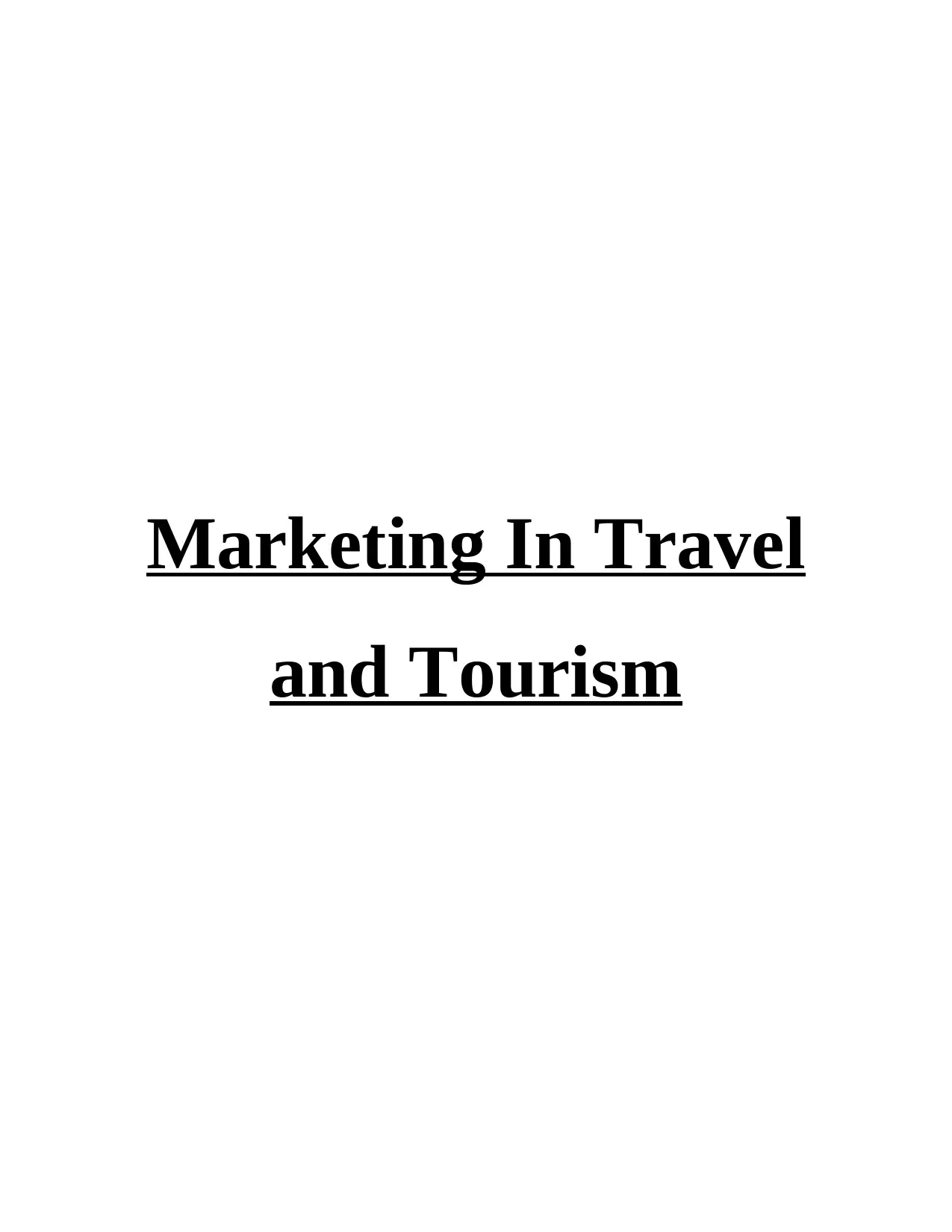
Marketing In Travel
and Tourism
and Tourism
Paraphrase This Document
Need a fresh take? Get an instant paraphrase of this document with our AI Paraphraser
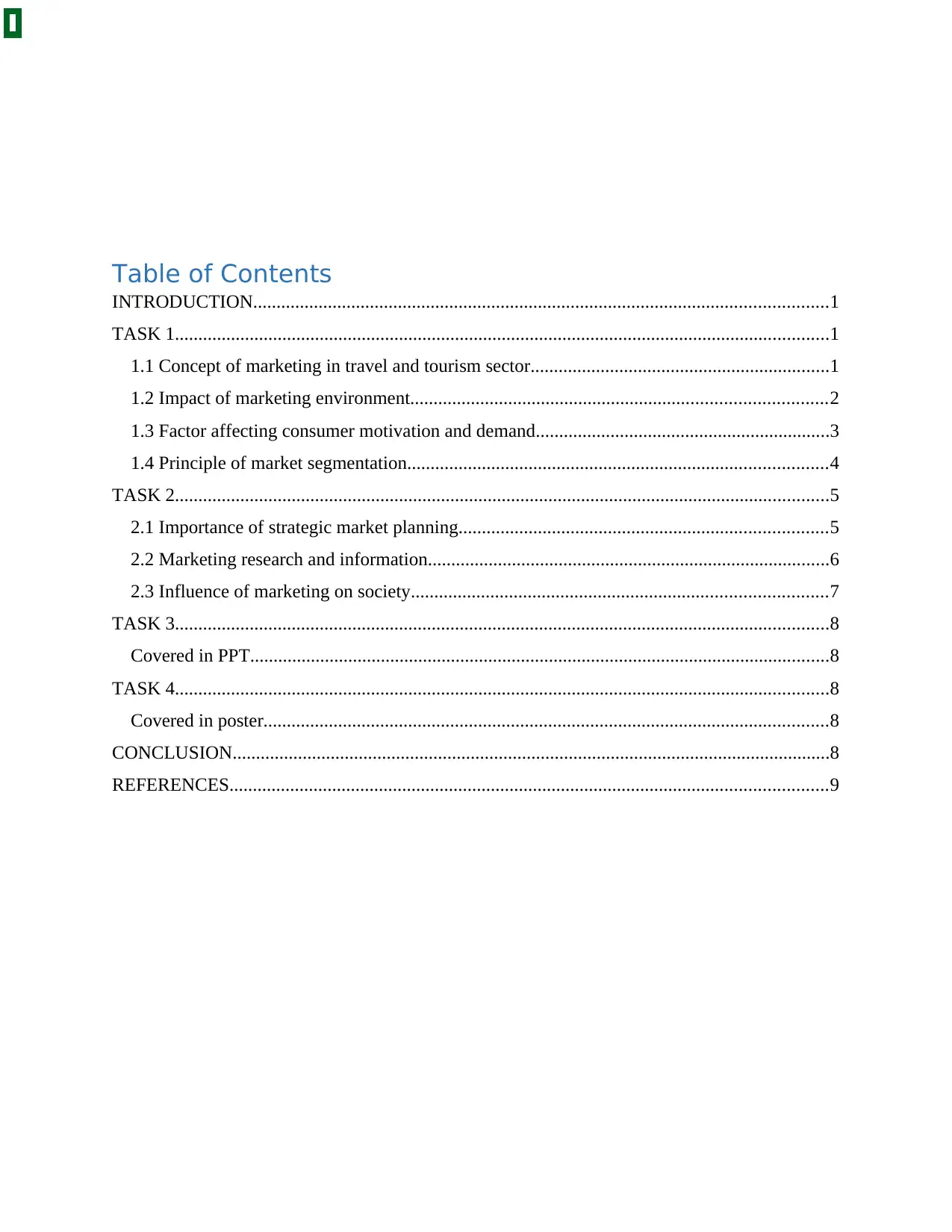
Table of Contents
INTRODUCTION...........................................................................................................................1
TASK 1............................................................................................................................................1
1.1 Concept of marketing in travel and tourism sector................................................................1
1.2 Impact of marketing environment.........................................................................................2
1.3 Factor affecting consumer motivation and demand...............................................................3
1.4 Principle of market segmentation..........................................................................................4
TASK 2............................................................................................................................................5
2.1 Importance of strategic market planning...............................................................................5
2.2 Marketing research and information......................................................................................6
2.3 Influence of marketing on society.........................................................................................7
TASK 3............................................................................................................................................8
Covered in PPT............................................................................................................................8
TASK 4............................................................................................................................................8
Covered in poster.........................................................................................................................8
CONCLUSION................................................................................................................................8
REFERENCES................................................................................................................................9
INTRODUCTION...........................................................................................................................1
TASK 1............................................................................................................................................1
1.1 Concept of marketing in travel and tourism sector................................................................1
1.2 Impact of marketing environment.........................................................................................2
1.3 Factor affecting consumer motivation and demand...............................................................3
1.4 Principle of market segmentation..........................................................................................4
TASK 2............................................................................................................................................5
2.1 Importance of strategic market planning...............................................................................5
2.2 Marketing research and information......................................................................................6
2.3 Influence of marketing on society.........................................................................................7
TASK 3............................................................................................................................................8
Covered in PPT............................................................................................................................8
TASK 4............................................................................................................................................8
Covered in poster.........................................................................................................................8
CONCLUSION................................................................................................................................8
REFERENCES................................................................................................................................9
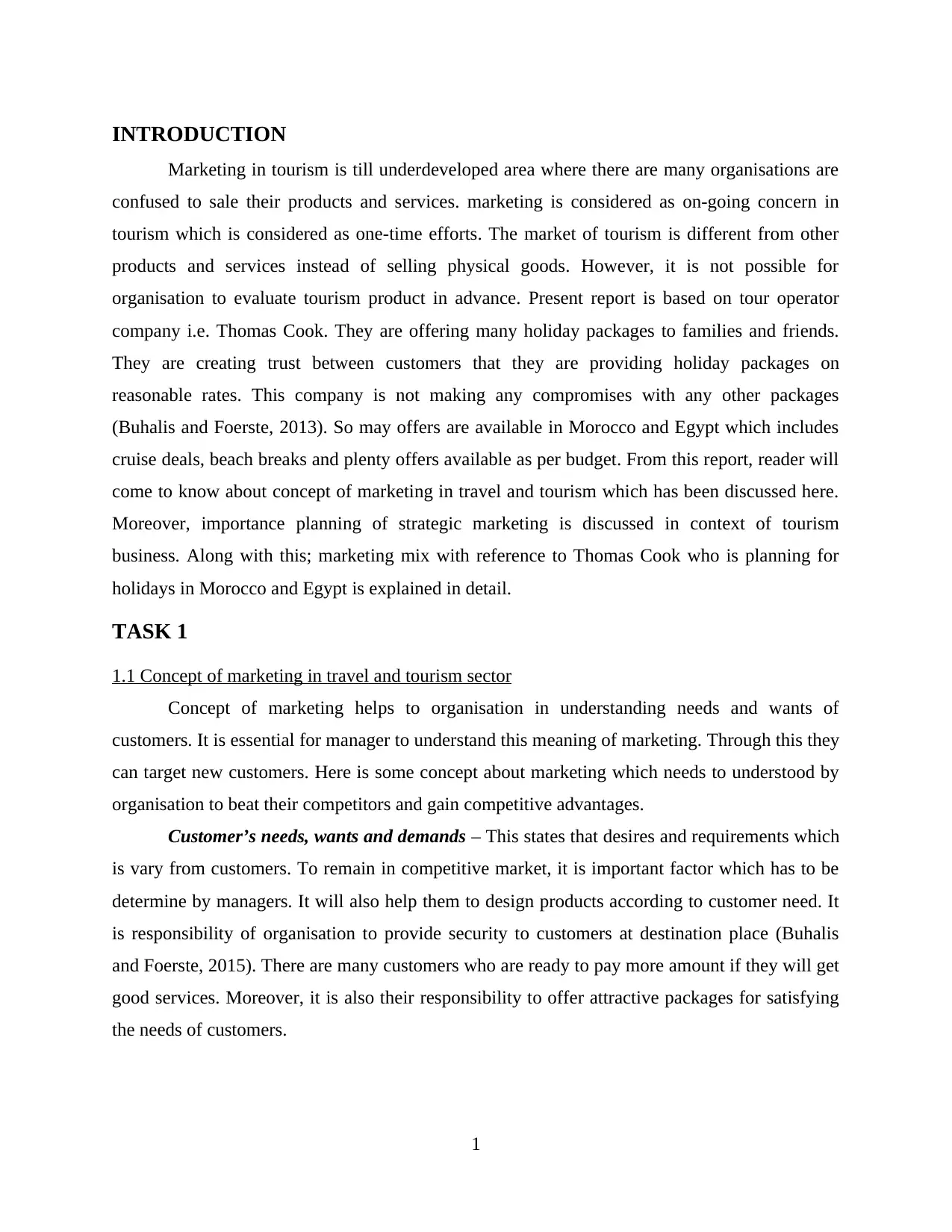
INTRODUCTION
Marketing in tourism is till underdeveloped area where there are many organisations are
confused to sale their products and services. marketing is considered as on-going concern in
tourism which is considered as one-time efforts. The market of tourism is different from other
products and services instead of selling physical goods. However, it is not possible for
organisation to evaluate tourism product in advance. Present report is based on tour operator
company i.e. Thomas Cook. They are offering many holiday packages to families and friends.
They are creating trust between customers that they are providing holiday packages on
reasonable rates. This company is not making any compromises with any other packages
(Buhalis and Foerste, 2013). So may offers are available in Morocco and Egypt which includes
cruise deals, beach breaks and plenty offers available as per budget. From this report, reader will
come to know about concept of marketing in travel and tourism which has been discussed here.
Moreover, importance planning of strategic marketing is discussed in context of tourism
business. Along with this; marketing mix with reference to Thomas Cook who is planning for
holidays in Morocco and Egypt is explained in detail.
TASK 1
1.1 Concept of marketing in travel and tourism sector
Concept of marketing helps to organisation in understanding needs and wants of
customers. It is essential for manager to understand this meaning of marketing. Through this they
can target new customers. Here is some concept about marketing which needs to understood by
organisation to beat their competitors and gain competitive advantages.
Customer’s needs, wants and demands – This states that desires and requirements which
is vary from customers. To remain in competitive market, it is important factor which has to be
determine by managers. It will also help them to design products according to customer need. It
is responsibility of organisation to provide security to customers at destination place (Buhalis
and Foerste, 2015). There are many customers who are ready to pay more amount if they will get
good services. Moreover, it is also their responsibility to offer attractive packages for satisfying
the needs of customers.
1
Marketing in tourism is till underdeveloped area where there are many organisations are
confused to sale their products and services. marketing is considered as on-going concern in
tourism which is considered as one-time efforts. The market of tourism is different from other
products and services instead of selling physical goods. However, it is not possible for
organisation to evaluate tourism product in advance. Present report is based on tour operator
company i.e. Thomas Cook. They are offering many holiday packages to families and friends.
They are creating trust between customers that they are providing holiday packages on
reasonable rates. This company is not making any compromises with any other packages
(Buhalis and Foerste, 2013). So may offers are available in Morocco and Egypt which includes
cruise deals, beach breaks and plenty offers available as per budget. From this report, reader will
come to know about concept of marketing in travel and tourism which has been discussed here.
Moreover, importance planning of strategic marketing is discussed in context of tourism
business. Along with this; marketing mix with reference to Thomas Cook who is planning for
holidays in Morocco and Egypt is explained in detail.
TASK 1
1.1 Concept of marketing in travel and tourism sector
Concept of marketing helps to organisation in understanding needs and wants of
customers. It is essential for manager to understand this meaning of marketing. Through this they
can target new customers. Here is some concept about marketing which needs to understood by
organisation to beat their competitors and gain competitive advantages.
Customer’s needs, wants and demands – This states that desires and requirements which
is vary from customers. To remain in competitive market, it is important factor which has to be
determine by managers. It will also help them to design products according to customer need. It
is responsibility of organisation to provide security to customers at destination place (Buhalis
and Foerste, 2015). There are many customers who are ready to pay more amount if they will get
good services. Moreover, it is also their responsibility to offer attractive packages for satisfying
the needs of customers.
1
⊘ This is a preview!⊘
Do you want full access?
Subscribe today to unlock all pages.

Trusted by 1+ million students worldwide
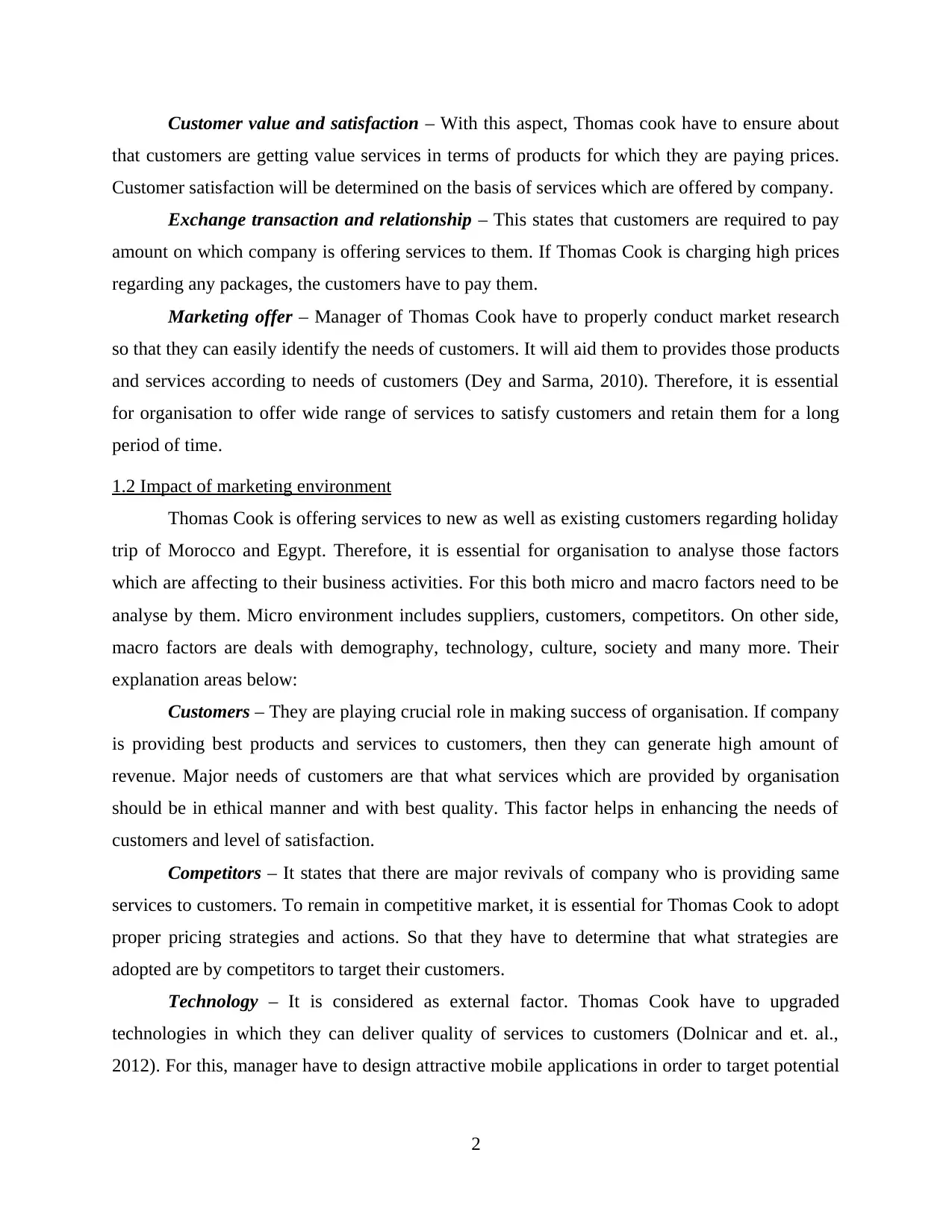
Customer value and satisfaction – With this aspect, Thomas cook have to ensure about
that customers are getting value services in terms of products for which they are paying prices.
Customer satisfaction will be determined on the basis of services which are offered by company.
Exchange transaction and relationship – This states that customers are required to pay
amount on which company is offering services to them. If Thomas Cook is charging high prices
regarding any packages, the customers have to pay them.
Marketing offer – Manager of Thomas Cook have to properly conduct market research
so that they can easily identify the needs of customers. It will aid them to provides those products
and services according to needs of customers (Dey and Sarma, 2010). Therefore, it is essential
for organisation to offer wide range of services to satisfy customers and retain them for a long
period of time.
1.2 Impact of marketing environment
Thomas Cook is offering services to new as well as existing customers regarding holiday
trip of Morocco and Egypt. Therefore, it is essential for organisation to analyse those factors
which are affecting to their business activities. For this both micro and macro factors need to be
analyse by them. Micro environment includes suppliers, customers, competitors. On other side,
macro factors are deals with demography, technology, culture, society and many more. Their
explanation areas below:
Customers – They are playing crucial role in making success of organisation. If company
is providing best products and services to customers, then they can generate high amount of
revenue. Major needs of customers are that what services which are provided by organisation
should be in ethical manner and with best quality. This factor helps in enhancing the needs of
customers and level of satisfaction.
Competitors – It states that there are major revivals of company who is providing same
services to customers. To remain in competitive market, it is essential for Thomas Cook to adopt
proper pricing strategies and actions. So that they have to determine that what strategies are
adopted are by competitors to target their customers.
Technology – It is considered as external factor. Thomas Cook have to upgraded
technologies in which they can deliver quality of services to customers (Dolnicar and et. al.,
2012). For this, manager have to design attractive mobile applications in order to target potential
2
that customers are getting value services in terms of products for which they are paying prices.
Customer satisfaction will be determined on the basis of services which are offered by company.
Exchange transaction and relationship – This states that customers are required to pay
amount on which company is offering services to them. If Thomas Cook is charging high prices
regarding any packages, the customers have to pay them.
Marketing offer – Manager of Thomas Cook have to properly conduct market research
so that they can easily identify the needs of customers. It will aid them to provides those products
and services according to needs of customers (Dey and Sarma, 2010). Therefore, it is essential
for organisation to offer wide range of services to satisfy customers and retain them for a long
period of time.
1.2 Impact of marketing environment
Thomas Cook is offering services to new as well as existing customers regarding holiday
trip of Morocco and Egypt. Therefore, it is essential for organisation to analyse those factors
which are affecting to their business activities. For this both micro and macro factors need to be
analyse by them. Micro environment includes suppliers, customers, competitors. On other side,
macro factors are deals with demography, technology, culture, society and many more. Their
explanation areas below:
Customers – They are playing crucial role in making success of organisation. If company
is providing best products and services to customers, then they can generate high amount of
revenue. Major needs of customers are that what services which are provided by organisation
should be in ethical manner and with best quality. This factor helps in enhancing the needs of
customers and level of satisfaction.
Competitors – It states that there are major revivals of company who is providing same
services to customers. To remain in competitive market, it is essential for Thomas Cook to adopt
proper pricing strategies and actions. So that they have to determine that what strategies are
adopted are by competitors to target their customers.
Technology – It is considered as external factor. Thomas Cook have to upgraded
technologies in which they can deliver quality of services to customers (Dolnicar and et. al.,
2012). For this, manager have to design attractive mobile applications in order to target potential
2
Paraphrase This Document
Need a fresh take? Get an instant paraphrase of this document with our AI Paraphraser
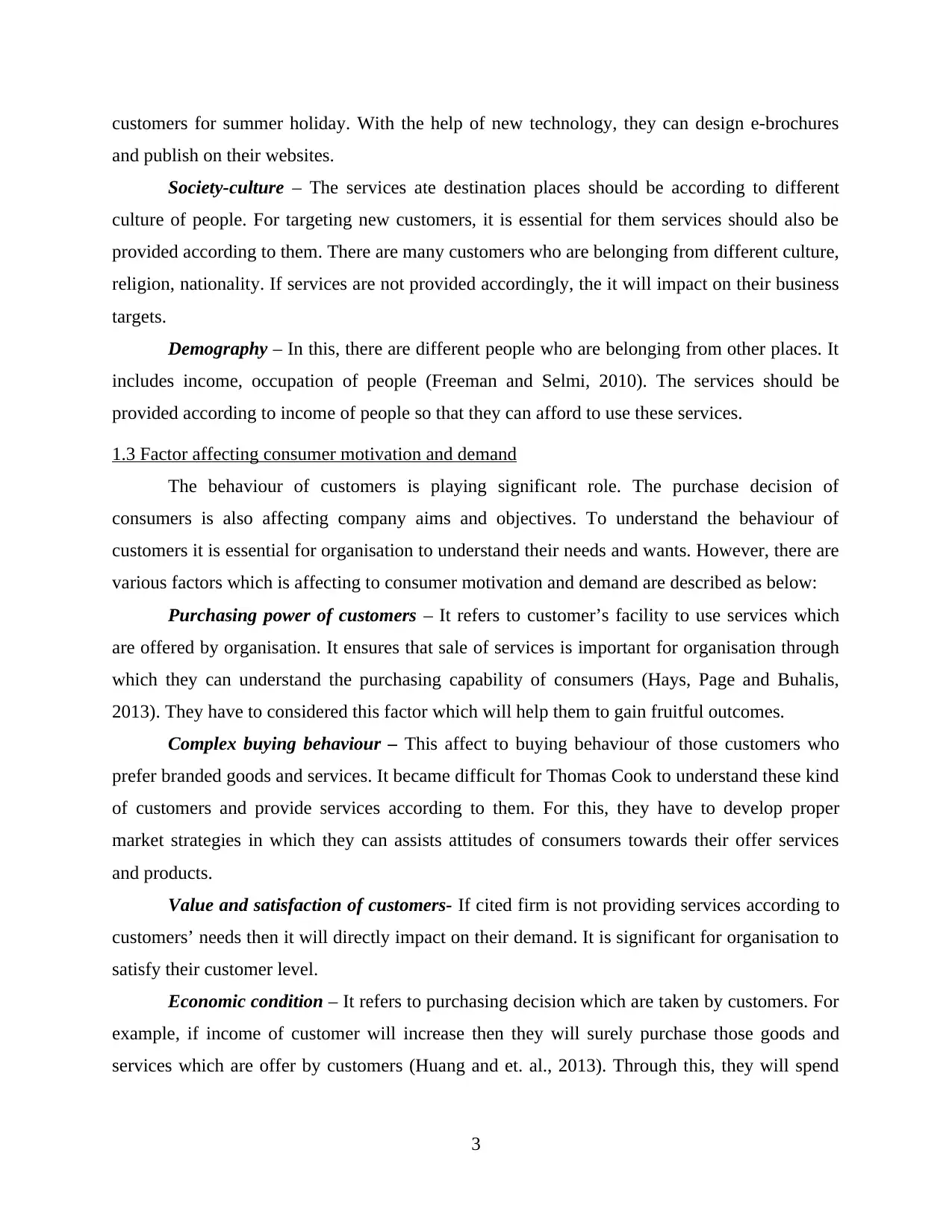
customers for summer holiday. With the help of new technology, they can design e-brochures
and publish on their websites.
Society-culture – The services ate destination places should be according to different
culture of people. For targeting new customers, it is essential for them services should also be
provided according to them. There are many customers who are belonging from different culture,
religion, nationality. If services are not provided accordingly, the it will impact on their business
targets.
Demography – In this, there are different people who are belonging from other places. It
includes income, occupation of people (Freeman and Selmi, 2010). The services should be
provided according to income of people so that they can afford to use these services.
1.3 Factor affecting consumer motivation and demand
The behaviour of customers is playing significant role. The purchase decision of
consumers is also affecting company aims and objectives. To understand the behaviour of
customers it is essential for organisation to understand their needs and wants. However, there are
various factors which is affecting to consumer motivation and demand are described as below:
Purchasing power of customers – It refers to customer’s facility to use services which
are offered by organisation. It ensures that sale of services is important for organisation through
which they can understand the purchasing capability of consumers (Hays, Page and Buhalis,
2013). They have to considered this factor which will help them to gain fruitful outcomes.
Complex buying behaviour – This affect to buying behaviour of those customers who
prefer branded goods and services. It became difficult for Thomas Cook to understand these kind
of customers and provide services according to them. For this, they have to develop proper
market strategies in which they can assists attitudes of consumers towards their offer services
and products.
Value and satisfaction of customers- If cited firm is not providing services according to
customers’ needs then it will directly impact on their demand. It is significant for organisation to
satisfy their customer level.
Economic condition – It refers to purchasing decision which are taken by customers. For
example, if income of customer will increase then they will surely purchase those goods and
services which are offer by customers (Huang and et. al., 2013). Through this, they will spend
3
and publish on their websites.
Society-culture – The services ate destination places should be according to different
culture of people. For targeting new customers, it is essential for them services should also be
provided according to them. There are many customers who are belonging from different culture,
religion, nationality. If services are not provided accordingly, the it will impact on their business
targets.
Demography – In this, there are different people who are belonging from other places. It
includes income, occupation of people (Freeman and Selmi, 2010). The services should be
provided according to income of people so that they can afford to use these services.
1.3 Factor affecting consumer motivation and demand
The behaviour of customers is playing significant role. The purchase decision of
consumers is also affecting company aims and objectives. To understand the behaviour of
customers it is essential for organisation to understand their needs and wants. However, there are
various factors which is affecting to consumer motivation and demand are described as below:
Purchasing power of customers – It refers to customer’s facility to use services which
are offered by organisation. It ensures that sale of services is important for organisation through
which they can understand the purchasing capability of consumers (Hays, Page and Buhalis,
2013). They have to considered this factor which will help them to gain fruitful outcomes.
Complex buying behaviour – This affect to buying behaviour of those customers who
prefer branded goods and services. It became difficult for Thomas Cook to understand these kind
of customers and provide services according to them. For this, they have to develop proper
market strategies in which they can assists attitudes of consumers towards their offer services
and products.
Value and satisfaction of customers- If cited firm is not providing services according to
customers’ needs then it will directly impact on their demand. It is significant for organisation to
satisfy their customer level.
Economic condition – It refers to purchasing decision which are taken by customers. For
example, if income of customer will increase then they will surely purchase those goods and
services which are offer by customers (Huang and et. al., 2013). Through this, they will spend
3
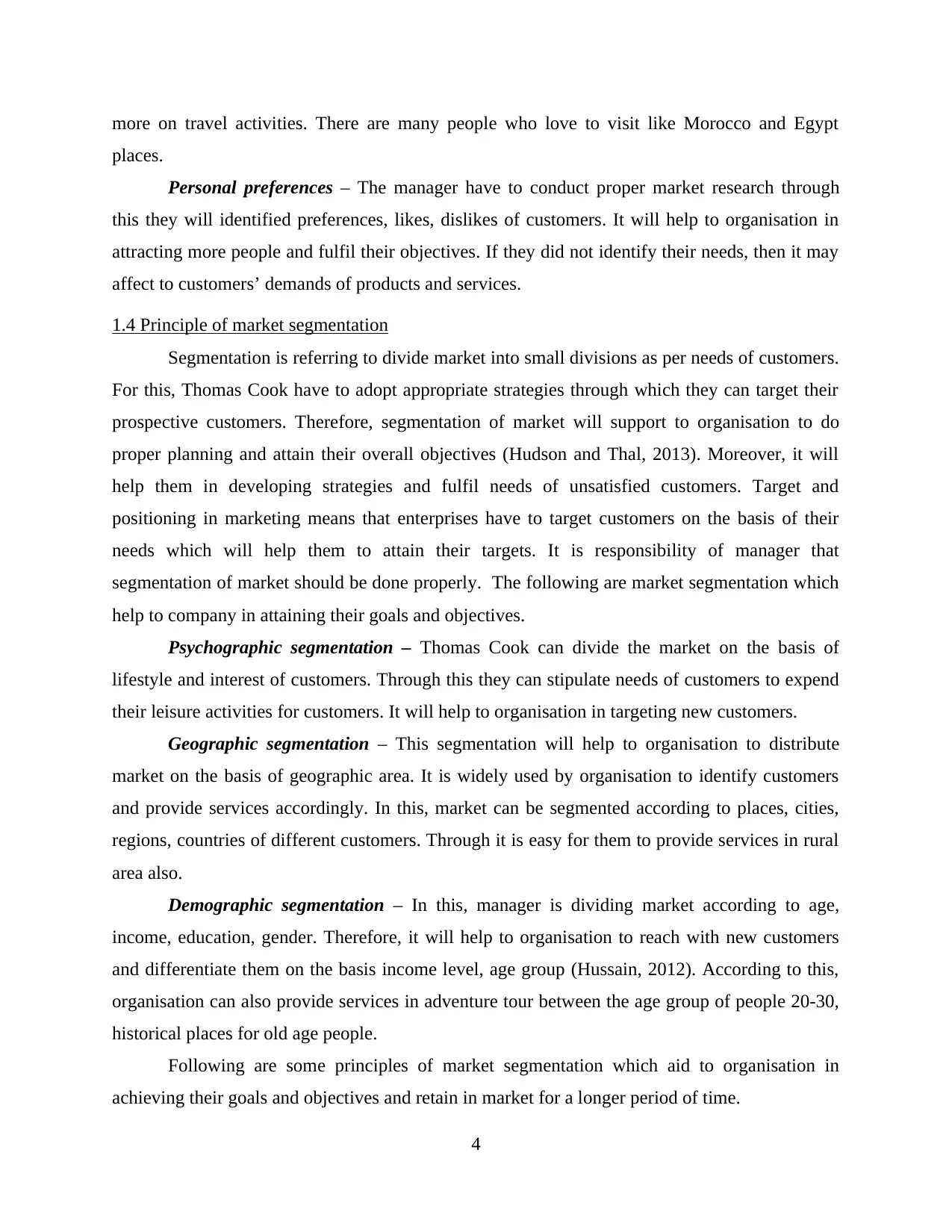
more on travel activities. There are many people who love to visit like Morocco and Egypt
places.
Personal preferences – The manager have to conduct proper market research through
this they will identified preferences, likes, dislikes of customers. It will help to organisation in
attracting more people and fulfil their objectives. If they did not identify their needs, then it may
affect to customers’ demands of products and services.
1.4 Principle of market segmentation
Segmentation is referring to divide market into small divisions as per needs of customers.
For this, Thomas Cook have to adopt appropriate strategies through which they can target their
prospective customers. Therefore, segmentation of market will support to organisation to do
proper planning and attain their overall objectives (Hudson and Thal, 2013). Moreover, it will
help them in developing strategies and fulfil needs of unsatisfied customers. Target and
positioning in marketing means that enterprises have to target customers on the basis of their
needs which will help them to attain their targets. It is responsibility of manager that
segmentation of market should be done properly. The following are market segmentation which
help to company in attaining their goals and objectives.
Psychographic segmentation – Thomas Cook can divide the market on the basis of
lifestyle and interest of customers. Through this they can stipulate needs of customers to expend
their leisure activities for customers. It will help to organisation in targeting new customers.
Geographic segmentation – This segmentation will help to organisation to distribute
market on the basis of geographic area. It is widely used by organisation to identify customers
and provide services accordingly. In this, market can be segmented according to places, cities,
regions, countries of different customers. Through it is easy for them to provide services in rural
area also.
Demographic segmentation – In this, manager is dividing market according to age,
income, education, gender. Therefore, it will help to organisation to reach with new customers
and differentiate them on the basis income level, age group (Hussain, 2012). According to this,
organisation can also provide services in adventure tour between the age group of people 20-30,
historical places for old age people.
Following are some principles of market segmentation which aid to organisation in
achieving their goals and objectives and retain in market for a longer period of time.
4
places.
Personal preferences – The manager have to conduct proper market research through
this they will identified preferences, likes, dislikes of customers. It will help to organisation in
attracting more people and fulfil their objectives. If they did not identify their needs, then it may
affect to customers’ demands of products and services.
1.4 Principle of market segmentation
Segmentation is referring to divide market into small divisions as per needs of customers.
For this, Thomas Cook have to adopt appropriate strategies through which they can target their
prospective customers. Therefore, segmentation of market will support to organisation to do
proper planning and attain their overall objectives (Hudson and Thal, 2013). Moreover, it will
help them in developing strategies and fulfil needs of unsatisfied customers. Target and
positioning in marketing means that enterprises have to target customers on the basis of their
needs which will help them to attain their targets. It is responsibility of manager that
segmentation of market should be done properly. The following are market segmentation which
help to company in attaining their goals and objectives.
Psychographic segmentation – Thomas Cook can divide the market on the basis of
lifestyle and interest of customers. Through this they can stipulate needs of customers to expend
their leisure activities for customers. It will help to organisation in targeting new customers.
Geographic segmentation – This segmentation will help to organisation to distribute
market on the basis of geographic area. It is widely used by organisation to identify customers
and provide services accordingly. In this, market can be segmented according to places, cities,
regions, countries of different customers. Through it is easy for them to provide services in rural
area also.
Demographic segmentation – In this, manager is dividing market according to age,
income, education, gender. Therefore, it will help to organisation to reach with new customers
and differentiate them on the basis income level, age group (Hussain, 2012). According to this,
organisation can also provide services in adventure tour between the age group of people 20-30,
historical places for old age people.
Following are some principles of market segmentation which aid to organisation in
achieving their goals and objectives and retain in market for a longer period of time.
4
⊘ This is a preview!⊘
Do you want full access?
Subscribe today to unlock all pages.

Trusted by 1+ million students worldwide
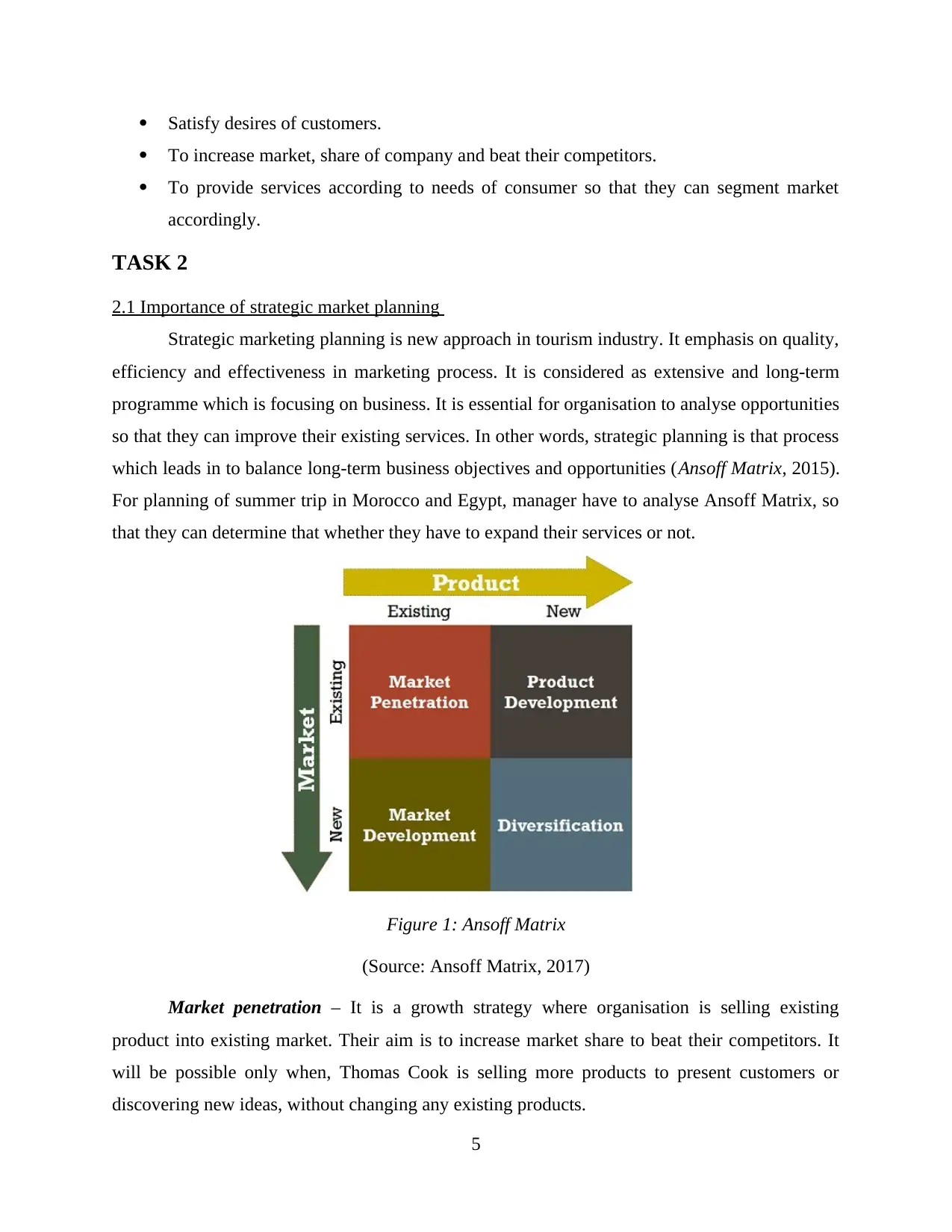
Satisfy desires of customers.
To increase market, share of company and beat their competitors.
To provide services according to needs of consumer so that they can segment market
accordingly.
TASK 2
2.1 Importance of strategic market planning
Strategic marketing planning is new approach in tourism industry. It emphasis on quality,
efficiency and effectiveness in marketing process. It is considered as extensive and long-term
programme which is focusing on business. It is essential for organisation to analyse opportunities
so that they can improve their existing services. In other words, strategic planning is that process
which leads in to balance long-term business objectives and opportunities (Ansoff Matrix, 2015).
For planning of summer trip in Morocco and Egypt, manager have to analyse Ansoff Matrix, so
that they can determine that whether they have to expand their services or not.
Figure 1: Ansoff Matrix
(Source: Ansoff Matrix, 2017)
Market penetration – It is a growth strategy where organisation is selling existing
product into existing market. Their aim is to increase market share to beat their competitors. It
will be possible only when, Thomas Cook is selling more products to present customers or
discovering new ideas, without changing any existing products.
5
To increase market, share of company and beat their competitors.
To provide services according to needs of consumer so that they can segment market
accordingly.
TASK 2
2.1 Importance of strategic market planning
Strategic marketing planning is new approach in tourism industry. It emphasis on quality,
efficiency and effectiveness in marketing process. It is considered as extensive and long-term
programme which is focusing on business. It is essential for organisation to analyse opportunities
so that they can improve their existing services. In other words, strategic planning is that process
which leads in to balance long-term business objectives and opportunities (Ansoff Matrix, 2015).
For planning of summer trip in Morocco and Egypt, manager have to analyse Ansoff Matrix, so
that they can determine that whether they have to expand their services or not.
Figure 1: Ansoff Matrix
(Source: Ansoff Matrix, 2017)
Market penetration – It is a growth strategy where organisation is selling existing
product into existing market. Their aim is to increase market share to beat their competitors. It
will be possible only when, Thomas Cook is selling more products to present customers or
discovering new ideas, without changing any existing products.
5
Paraphrase This Document
Need a fresh take? Get an instant paraphrase of this document with our AI Paraphraser
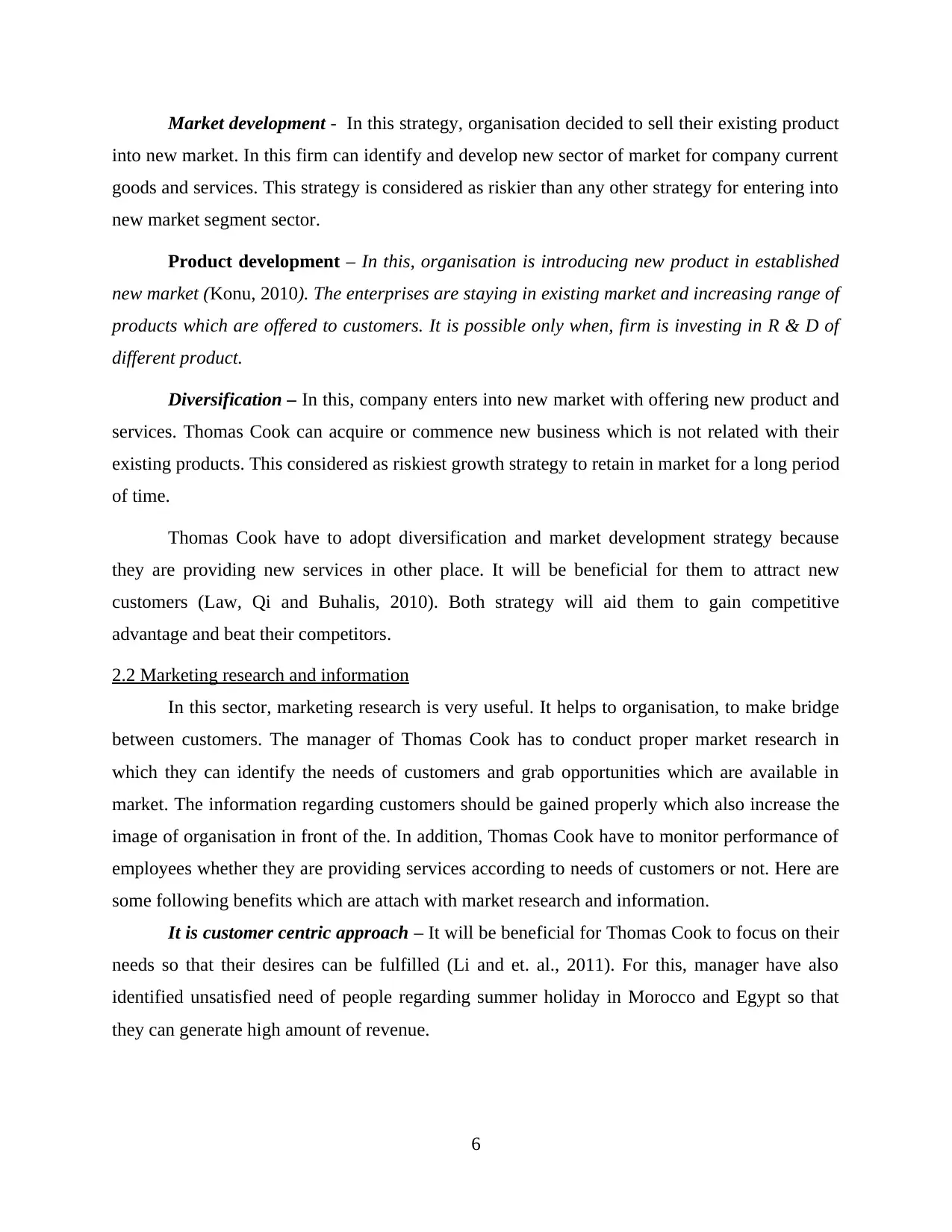
Market development - In this strategy, organisation decided to sell their existing product
into new market. In this firm can identify and develop new sector of market for company current
goods and services. This strategy is considered as riskier than any other strategy for entering into
new market segment sector.
Product development – In this, organisation is introducing new product in established
new market (Konu, 2010). The enterprises are staying in existing market and increasing range of
products which are offered to customers. It is possible only when, firm is investing in R & D of
different product.
Diversification – In this, company enters into new market with offering new product and
services. Thomas Cook can acquire or commence new business which is not related with their
existing products. This considered as riskiest growth strategy to retain in market for a long period
of time.
Thomas Cook have to adopt diversification and market development strategy because
they are providing new services in other place. It will be beneficial for them to attract new
customers (Law, Qi and Buhalis, 2010). Both strategy will aid them to gain competitive
advantage and beat their competitors.
2.2 Marketing research and information
In this sector, marketing research is very useful. It helps to organisation, to make bridge
between customers. The manager of Thomas Cook has to conduct proper market research in
which they can identify the needs of customers and grab opportunities which are available in
market. The information regarding customers should be gained properly which also increase the
image of organisation in front of the. In addition, Thomas Cook have to monitor performance of
employees whether they are providing services according to needs of customers or not. Here are
some following benefits which are attach with market research and information.
It is customer centric approach – It will be beneficial for Thomas Cook to focus on their
needs so that their desires can be fulfilled (Li and et. al., 2011). For this, manager have also
identified unsatisfied need of people regarding summer holiday in Morocco and Egypt so that
they can generate high amount of revenue.
6
into new market. In this firm can identify and develop new sector of market for company current
goods and services. This strategy is considered as riskier than any other strategy for entering into
new market segment sector.
Product development – In this, organisation is introducing new product in established
new market (Konu, 2010). The enterprises are staying in existing market and increasing range of
products which are offered to customers. It is possible only when, firm is investing in R & D of
different product.
Diversification – In this, company enters into new market with offering new product and
services. Thomas Cook can acquire or commence new business which is not related with their
existing products. This considered as riskiest growth strategy to retain in market for a long period
of time.
Thomas Cook have to adopt diversification and market development strategy because
they are providing new services in other place. It will be beneficial for them to attract new
customers (Law, Qi and Buhalis, 2010). Both strategy will aid them to gain competitive
advantage and beat their competitors.
2.2 Marketing research and information
In this sector, marketing research is very useful. It helps to organisation, to make bridge
between customers. The manager of Thomas Cook has to conduct proper market research in
which they can identify the needs of customers and grab opportunities which are available in
market. The information regarding customers should be gained properly which also increase the
image of organisation in front of the. In addition, Thomas Cook have to monitor performance of
employees whether they are providing services according to needs of customers or not. Here are
some following benefits which are attach with market research and information.
It is customer centric approach – It will be beneficial for Thomas Cook to focus on their
needs so that their desires can be fulfilled (Li and et. al., 2011). For this, manager have also
identified unsatisfied need of people regarding summer holiday in Morocco and Egypt so that
they can generate high amount of revenue.
6
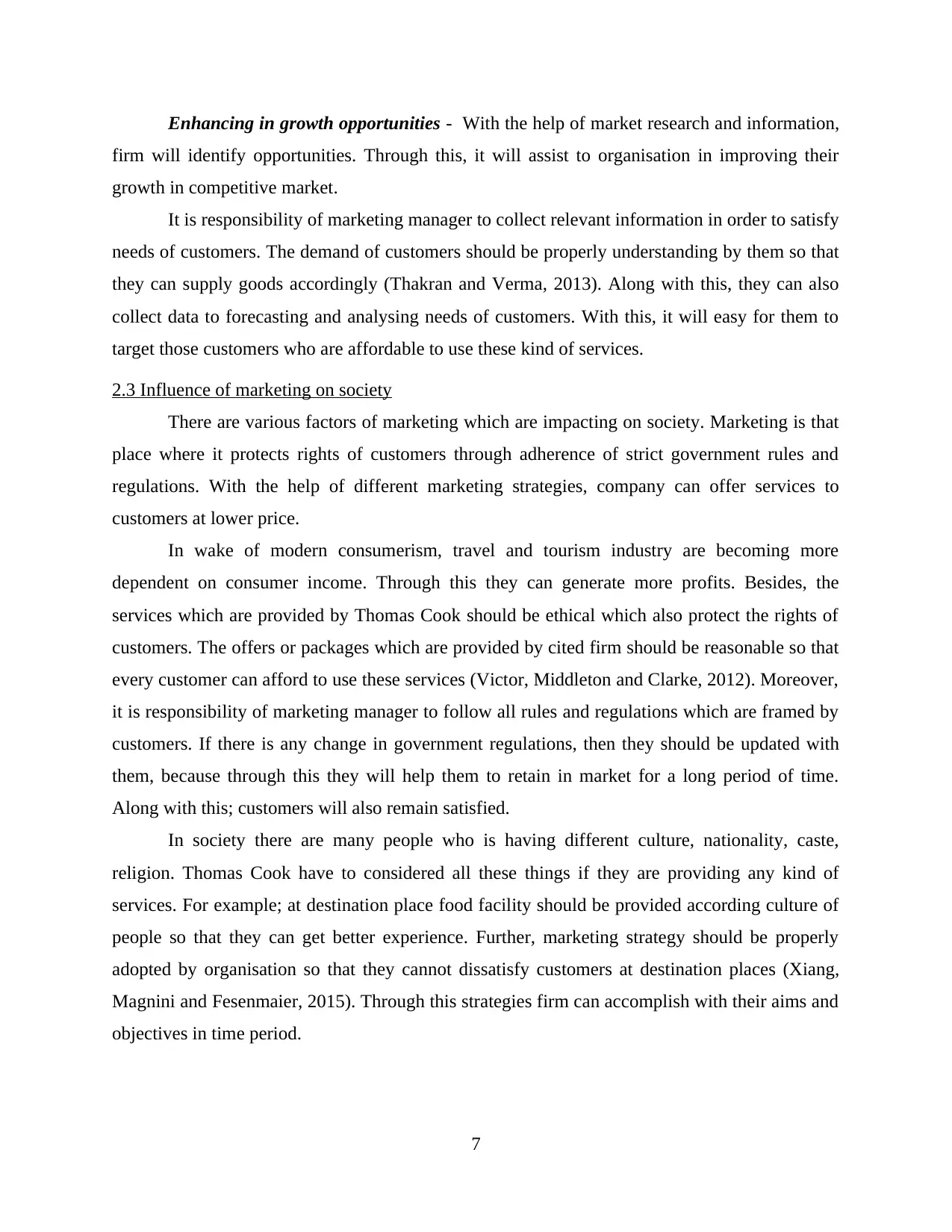
Enhancing in growth opportunities - With the help of market research and information,
firm will identify opportunities. Through this, it will assist to organisation in improving their
growth in competitive market.
It is responsibility of marketing manager to collect relevant information in order to satisfy
needs of customers. The demand of customers should be properly understanding by them so that
they can supply goods accordingly (Thakran and Verma, 2013). Along with this, they can also
collect data to forecasting and analysing needs of customers. With this, it will easy for them to
target those customers who are affordable to use these kind of services.
2.3 Influence of marketing on society
There are various factors of marketing which are impacting on society. Marketing is that
place where it protects rights of customers through adherence of strict government rules and
regulations. With the help of different marketing strategies, company can offer services to
customers at lower price.
In wake of modern consumerism, travel and tourism industry are becoming more
dependent on consumer income. Through this they can generate more profits. Besides, the
services which are provided by Thomas Cook should be ethical which also protect the rights of
customers. The offers or packages which are provided by cited firm should be reasonable so that
every customer can afford to use these services (Victor, Middleton and Clarke, 2012). Moreover,
it is responsibility of marketing manager to follow all rules and regulations which are framed by
customers. If there is any change in government regulations, then they should be updated with
them, because through this they will help them to retain in market for a long period of time.
Along with this; customers will also remain satisfied.
In society there are many people who is having different culture, nationality, caste,
religion. Thomas Cook have to considered all these things if they are providing any kind of
services. For example; at destination place food facility should be provided according culture of
people so that they can get better experience. Further, marketing strategy should be properly
adopted by organisation so that they cannot dissatisfy customers at destination places (Xiang,
Magnini and Fesenmaier, 2015). Through this strategies firm can accomplish with their aims and
objectives in time period.
7
firm will identify opportunities. Through this, it will assist to organisation in improving their
growth in competitive market.
It is responsibility of marketing manager to collect relevant information in order to satisfy
needs of customers. The demand of customers should be properly understanding by them so that
they can supply goods accordingly (Thakran and Verma, 2013). Along with this, they can also
collect data to forecasting and analysing needs of customers. With this, it will easy for them to
target those customers who are affordable to use these kind of services.
2.3 Influence of marketing on society
There are various factors of marketing which are impacting on society. Marketing is that
place where it protects rights of customers through adherence of strict government rules and
regulations. With the help of different marketing strategies, company can offer services to
customers at lower price.
In wake of modern consumerism, travel and tourism industry are becoming more
dependent on consumer income. Through this they can generate more profits. Besides, the
services which are provided by Thomas Cook should be ethical which also protect the rights of
customers. The offers or packages which are provided by cited firm should be reasonable so that
every customer can afford to use these services (Victor, Middleton and Clarke, 2012). Moreover,
it is responsibility of marketing manager to follow all rules and regulations which are framed by
customers. If there is any change in government regulations, then they should be updated with
them, because through this they will help them to retain in market for a long period of time.
Along with this; customers will also remain satisfied.
In society there are many people who is having different culture, nationality, caste,
religion. Thomas Cook have to considered all these things if they are providing any kind of
services. For example; at destination place food facility should be provided according culture of
people so that they can get better experience. Further, marketing strategy should be properly
adopted by organisation so that they cannot dissatisfy customers at destination places (Xiang,
Magnini and Fesenmaier, 2015). Through this strategies firm can accomplish with their aims and
objectives in time period.
7
⊘ This is a preview!⊘
Do you want full access?
Subscribe today to unlock all pages.

Trusted by 1+ million students worldwide
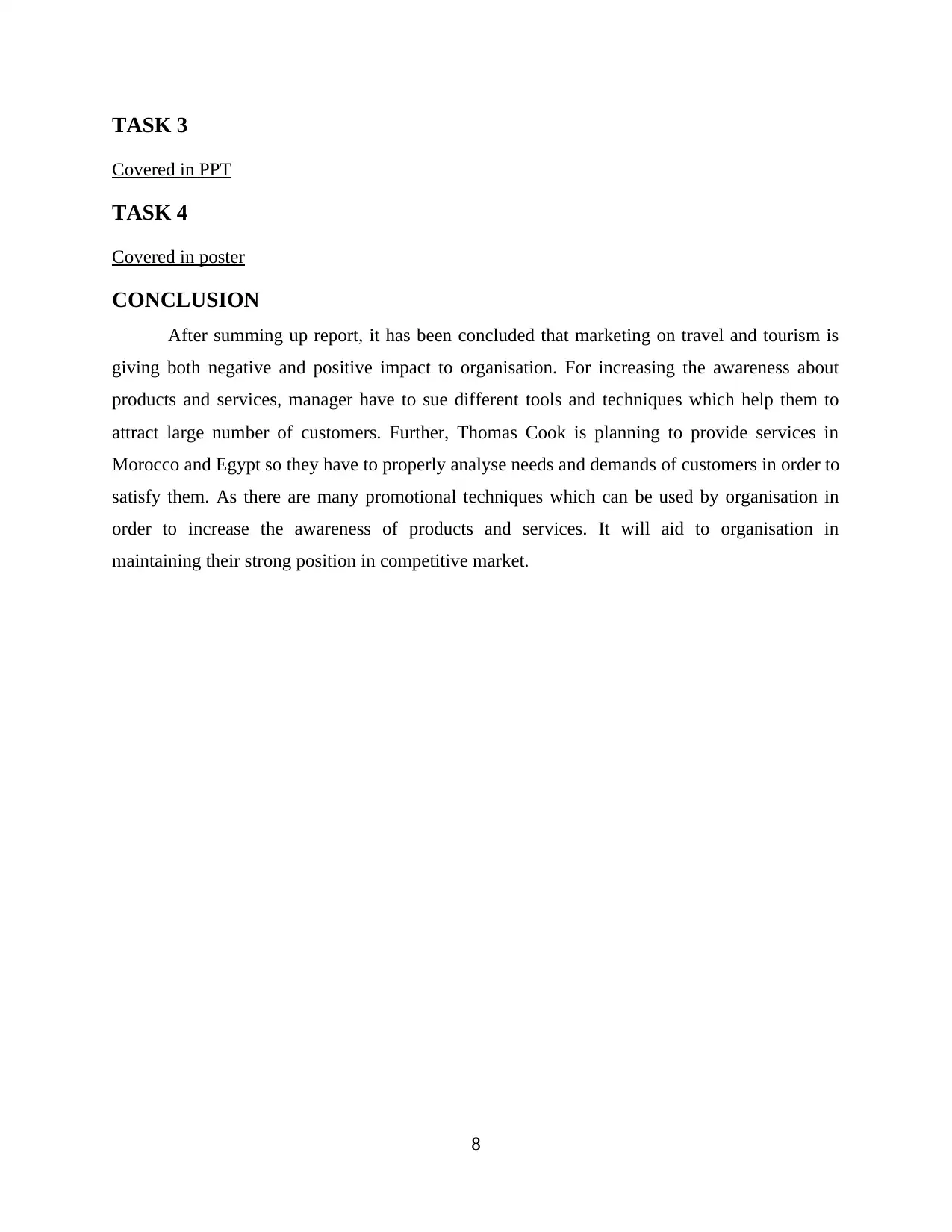
TASK 3
Covered in PPT
TASK 4
Covered in poster
CONCLUSION
After summing up report, it has been concluded that marketing on travel and tourism is
giving both negative and positive impact to organisation. For increasing the awareness about
products and services, manager have to sue different tools and techniques which help them to
attract large number of customers. Further, Thomas Cook is planning to provide services in
Morocco and Egypt so they have to properly analyse needs and demands of customers in order to
satisfy them. As there are many promotional techniques which can be used by organisation in
order to increase the awareness of products and services. It will aid to organisation in
maintaining their strong position in competitive market.
8
Covered in PPT
TASK 4
Covered in poster
CONCLUSION
After summing up report, it has been concluded that marketing on travel and tourism is
giving both negative and positive impact to organisation. For increasing the awareness about
products and services, manager have to sue different tools and techniques which help them to
attract large number of customers. Further, Thomas Cook is planning to provide services in
Morocco and Egypt so they have to properly analyse needs and demands of customers in order to
satisfy them. As there are many promotional techniques which can be used by organisation in
order to increase the awareness of products and services. It will aid to organisation in
maintaining their strong position in competitive market.
8
Paraphrase This Document
Need a fresh take? Get an instant paraphrase of this document with our AI Paraphraser
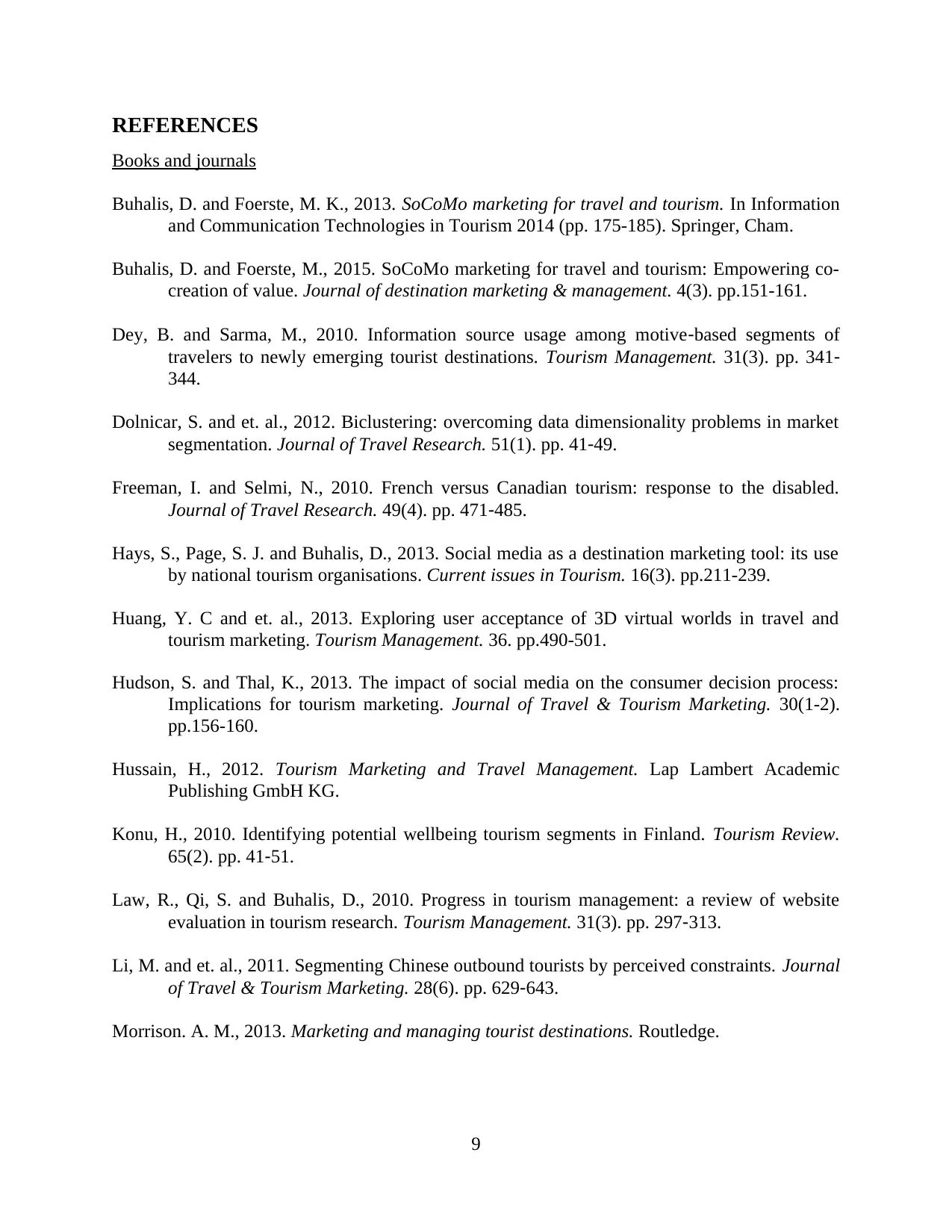
REFERENCES
Books and journals
Buhalis, D. and Foerste, M. K., 2013. SoCoMo marketing for travel and tourism. In Information
and Communication Technologies in Tourism 2014 (pp. 175-185). Springer, Cham.
Buhalis, D. and Foerste, M., 2015. SoCoMo marketing for travel and tourism: Empowering co-
creation of value. Journal of destination marketing & management. 4(3). pp.151-161.
Dey, B. and Sarma, M., 2010. Information source usage among motive‐based segments of
travelers to newly emerging tourist destinations. Tourism Management. 31(3). pp. 341‐
344.
Dolnicar, S. and et. al., 2012. Biclustering: overcoming data dimensionality problems in market
segmentation. Journal of Travel Research. 51(1). pp. 41‐49.
Freeman, I. and Selmi, N., 2010. French versus Canadian tourism: response to the disabled.
Journal of Travel Research. 49(4). pp. 471‐485.
Hays, S., Page, S. J. and Buhalis, D., 2013. Social media as a destination marketing tool: its use
by national tourism organisations. Current issues in Tourism. 16(3). pp.211-239.
Huang, Y. C and et. al., 2013. Exploring user acceptance of 3D virtual worlds in travel and
tourism marketing. Tourism Management. 36. pp.490-501.
Hudson, S. and Thal, K., 2013. The impact of social media on the consumer decision process:
Implications for tourism marketing. Journal of Travel & Tourism Marketing. 30(1-2).
pp.156-160.
Hussain, H., 2012. Tourism Marketing and Travel Management. Lap Lambert Academic
Publishing GmbH KG.
Konu, H., 2010. Identifying potential wellbeing tourism segments in Finland. Tourism Review.
65(2). pp. 41‐51.
Law, R., Qi, S. and Buhalis, D., 2010. Progress in tourism management: a review of website
evaluation in tourism research. Tourism Management. 31(3). pp. 297‐313.
Li, M. and et. al., 2011. Segmenting Chinese outbound tourists by perceived constraints. Journal
of Travel & Tourism Marketing. 28(6). pp. 629‐643.
Morrison. A. M., 2013. Marketing and managing tourist destinations. Routledge.
9
Books and journals
Buhalis, D. and Foerste, M. K., 2013. SoCoMo marketing for travel and tourism. In Information
and Communication Technologies in Tourism 2014 (pp. 175-185). Springer, Cham.
Buhalis, D. and Foerste, M., 2015. SoCoMo marketing for travel and tourism: Empowering co-
creation of value. Journal of destination marketing & management. 4(3). pp.151-161.
Dey, B. and Sarma, M., 2010. Information source usage among motive‐based segments of
travelers to newly emerging tourist destinations. Tourism Management. 31(3). pp. 341‐
344.
Dolnicar, S. and et. al., 2012. Biclustering: overcoming data dimensionality problems in market
segmentation. Journal of Travel Research. 51(1). pp. 41‐49.
Freeman, I. and Selmi, N., 2010. French versus Canadian tourism: response to the disabled.
Journal of Travel Research. 49(4). pp. 471‐485.
Hays, S., Page, S. J. and Buhalis, D., 2013. Social media as a destination marketing tool: its use
by national tourism organisations. Current issues in Tourism. 16(3). pp.211-239.
Huang, Y. C and et. al., 2013. Exploring user acceptance of 3D virtual worlds in travel and
tourism marketing. Tourism Management. 36. pp.490-501.
Hudson, S. and Thal, K., 2013. The impact of social media on the consumer decision process:
Implications for tourism marketing. Journal of Travel & Tourism Marketing. 30(1-2).
pp.156-160.
Hussain, H., 2012. Tourism Marketing and Travel Management. Lap Lambert Academic
Publishing GmbH KG.
Konu, H., 2010. Identifying potential wellbeing tourism segments in Finland. Tourism Review.
65(2). pp. 41‐51.
Law, R., Qi, S. and Buhalis, D., 2010. Progress in tourism management: a review of website
evaluation in tourism research. Tourism Management. 31(3). pp. 297‐313.
Li, M. and et. al., 2011. Segmenting Chinese outbound tourists by perceived constraints. Journal
of Travel & Tourism Marketing. 28(6). pp. 629‐643.
Morrison. A. M., 2013. Marketing and managing tourist destinations. Routledge.
9
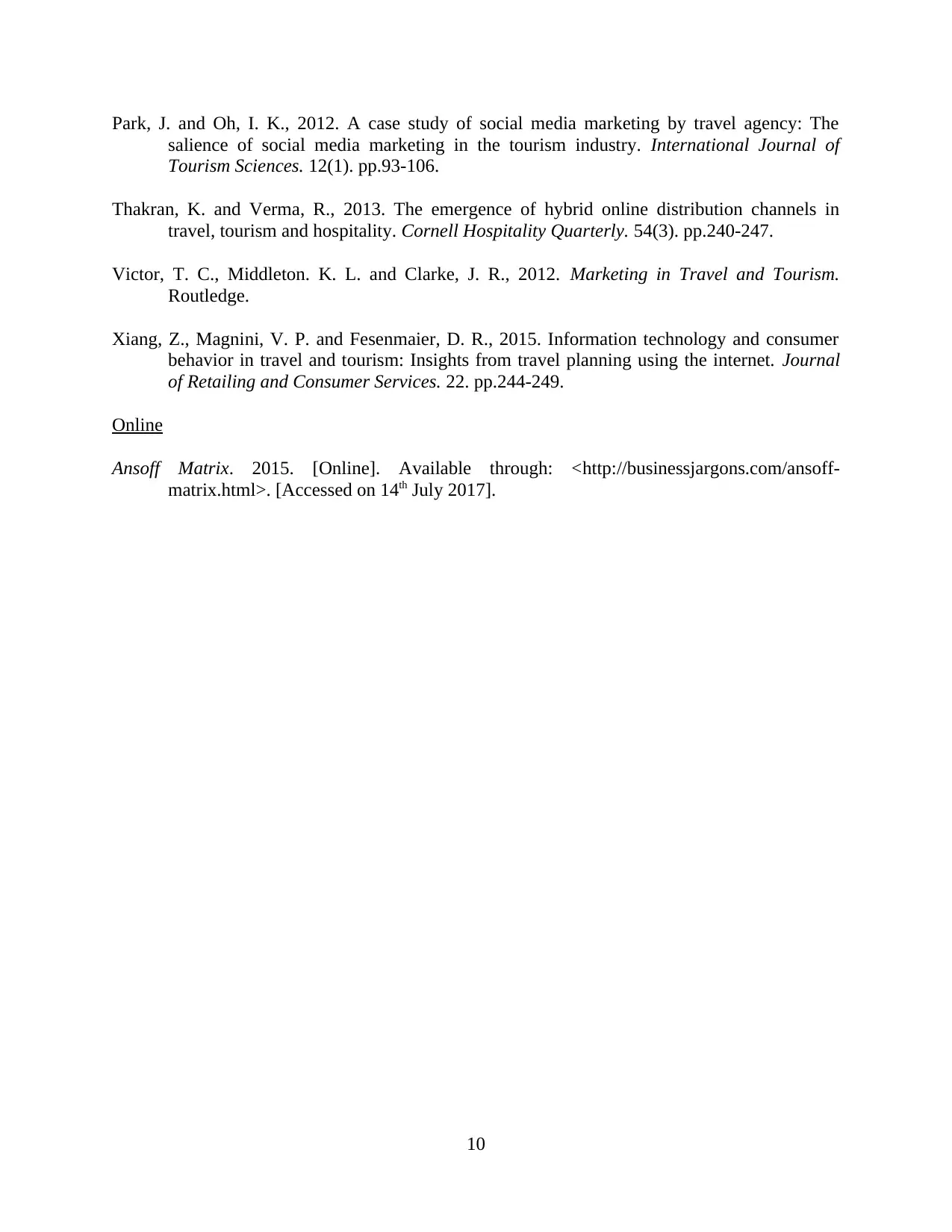
Park, J. and Oh, I. K., 2012. A case study of social media marketing by travel agency: The
salience of social media marketing in the tourism industry. International Journal of
Tourism Sciences. 12(1). pp.93-106.
Thakran, K. and Verma, R., 2013. The emergence of hybrid online distribution channels in
travel, tourism and hospitality. Cornell Hospitality Quarterly. 54(3). pp.240-247.
Victor, T. C., Middleton. K. L. and Clarke, J. R., 2012. Marketing in Travel and Tourism.
Routledge.
Xiang, Z., Magnini, V. P. and Fesenmaier, D. R., 2015. Information technology and consumer
behavior in travel and tourism: Insights from travel planning using the internet. Journal
of Retailing and Consumer Services. 22. pp.244-249.
Online
Ansoff Matrix. 2015. [Online]. Available through: <http://businessjargons.com/ansoff-
matrix.html>. [Accessed on 14th July 2017].
10
salience of social media marketing in the tourism industry. International Journal of
Tourism Sciences. 12(1). pp.93-106.
Thakran, K. and Verma, R., 2013. The emergence of hybrid online distribution channels in
travel, tourism and hospitality. Cornell Hospitality Quarterly. 54(3). pp.240-247.
Victor, T. C., Middleton. K. L. and Clarke, J. R., 2012. Marketing in Travel and Tourism.
Routledge.
Xiang, Z., Magnini, V. P. and Fesenmaier, D. R., 2015. Information technology and consumer
behavior in travel and tourism: Insights from travel planning using the internet. Journal
of Retailing and Consumer Services. 22. pp.244-249.
Online
Ansoff Matrix. 2015. [Online]. Available through: <http://businessjargons.com/ansoff-
matrix.html>. [Accessed on 14th July 2017].
10
⊘ This is a preview!⊘
Do you want full access?
Subscribe today to unlock all pages.

Trusted by 1+ million students worldwide
1 out of 12
Related Documents
Your All-in-One AI-Powered Toolkit for Academic Success.
+13062052269
info@desklib.com
Available 24*7 on WhatsApp / Email
![[object Object]](/_next/static/media/star-bottom.7253800d.svg)
Unlock your academic potential
Copyright © 2020–2025 A2Z Services. All Rights Reserved. Developed and managed by ZUCOL.





